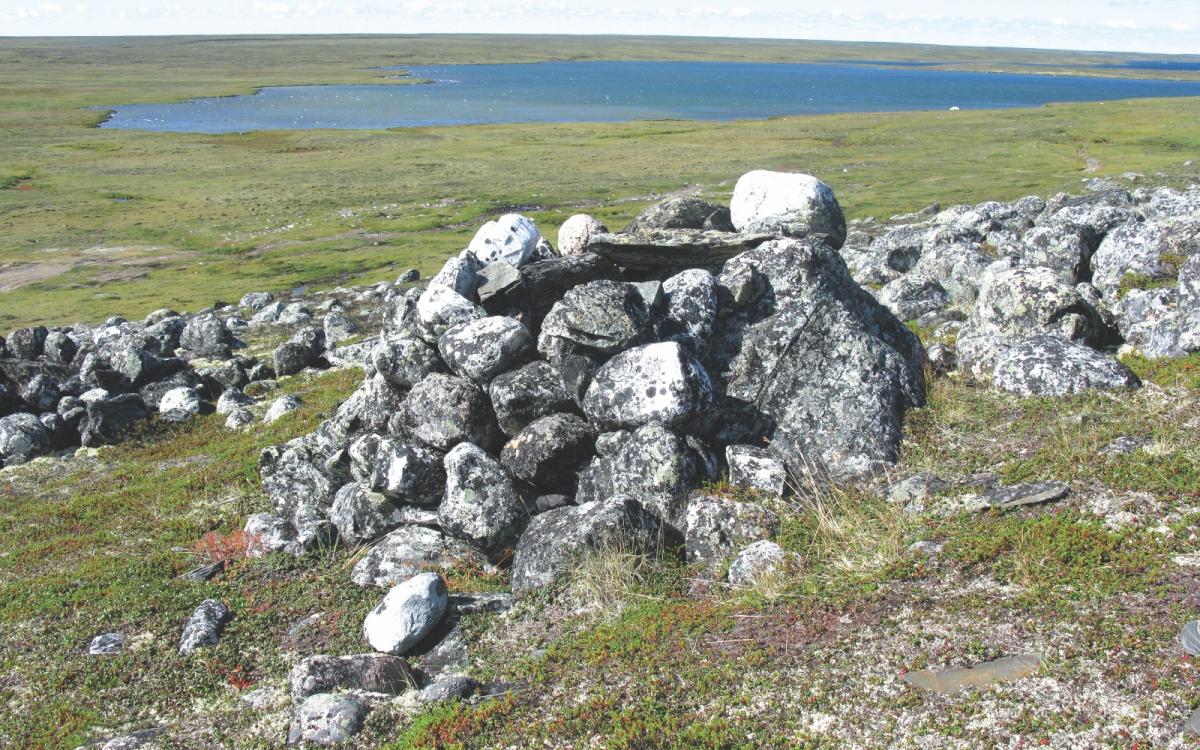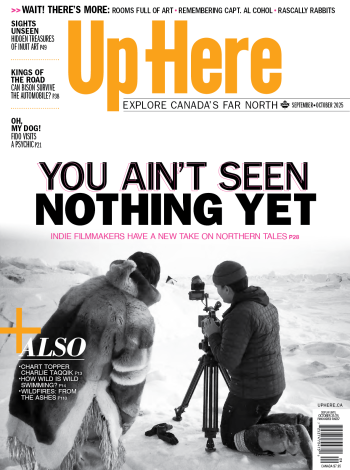The scent is delicious, fishy, rich, enticing…
It wafts over the tundra, drawing the attention of a prowling red fox. He puts his head down and traces the scent trail with absorption and skill, winding through large boulders and up the side of a rocky hill, and stops, nose up, twitching, mouth half open, tasting the attraction. It seems to come from a hill of rounded stones… Delicately, he rears up and places his front feet on the stones… stretching higher, higher… Lifting his head, he leaps lightly to the top of the pile, which turns out to be a rim of a crater in the stones. The scent is richer here… Saliva comes to his mouth. He crouches, sniffing the scent pools within the crater, and he leans further… further… edging out on the flat top of a stone. It teeters, and he pulls back, but it is too late. The stone suddenly slips sideways, falling into the darkness. The fox falls lightly into the centre of the cone of stone. On the floor, he finds a fish head and investigates it, pulling at the gills and cheeks, gulping the sweet flesh. Panic comes later when he realizes there is no way out… The sides are coated with ice and slant inward; his nails find no purchase. He is doomed. Doomed to starve or die at the end of a spear when the hunter checks the trap.
Sometimes, hiking on the tundra, and along our Arctic rivers, you come across a symmetrical pile of stones, and suddenly discover it is hollow inside, almost like an iglu of stone, constructed by Inuit. Or, on a rocky ridge above the sea, you might find a stone box on the land, with a rectangular chamber, a stone lintel over the door, and a groove made by stones set on either side of the entrance. If you are lucky, the door will still be in place, so you can better understand how this ingenious structure works.
These are stone fox traps, used in the past as vermin control, to remove marauding foxes (both red foxes and arctic foxes) seeking food in Inuit encampments. Foxes were agile, hard to spear, and highly destructive when allowed access to a caribou skin tent, skin blankets on the sleeping platform, or stored food in a tent or sod house. Stone traps required a lot of energy to build, but once constructed, they lasted for years, and required only baiting.
Before the coming of the traders to the Arctic coast and islands, foxes were eaten in times of starvation, or fed to sled dogs. Fox skins were considered of almost no value. They were used to clean babies, wipe out stone pots, almost like dishcloths. It was only with the coming of outsiders like traders, seeking fox skins for the European fashion trade, that fox skins acquired real value to Inuit. It was an artificial value—they could be traded for implements that made life much easier for Inuit across the Arctic. They were exchanged for needles, steel tools, knives, pots, primus stoves, flour, sugar, tea, and (perhaps most important), rifles, lead for bullets, and reloaders, all products of the white man’s world that made life so much easier across the Arctic.
And the traders brought other items that enabled a whole commercial enterprise to be set up around the trapping of white foxes—steel leghold traps, skinning knives, foods that allowed the hunters to spend less time hunting for food to feed their families, and more time trapping to provide furs to trade for household items. Credit systems developed, with the traders grubstaking trappers so they could spend less time hunting and more time trapping.
Life changed tremendously. Good trappers were able to buy more goods, and became the elite of the various groups of Inuit, especially in the Central Arctic.
Once the steel traps were introduced, the building of stone fox traps stopped. No one would spend the time and back-breaking work building a trap out of heavy rocks when a light leghold trap, easily carried on the dogsled, would do. So, any stone fox trap you see was likely built prior to 1900, and often much earlier. Some are very old, with lichens bridging stone to stone.
Types of fox traps, and how they worked:
The pulat type of fox trap is a horizontal chamber of fairly heavy rocks, with a narrow chamber in the middle, a stone lintel over the entrance. There were heavy rocks lined up at the sides that guided a flat rock acting as a door. The door was a flat heavy stone that slid down neatly into the slots made by the rocks. According to Elders Moses Aliyak, John Towtongie, and John Tatty of Rankin Inlet, the trigger system was very clever. A caribou antler was built into the back of the trap, and served as a column around which a leather thong was passed, much like in a pulley. In the entrance, a caribou tibia was set on its rounded end, and a round pebble was balanced in the shallow cups on the top end of the bone. The thong was tied around the tibia, run though the trap, passed around the antler pivot, and back to a fish head set on the ground inside the entrance of the trap. The bait had to be something the fox would want to take away, and not eat in place. The flat rock “door” was balanced on one corner, with the other corner set onto the pebble on the top of the tibia. This arrangement was very strong compression-wise, and very unstable laterally. The slightest touch would cause the pebble to roll and the bone to become unbalanced, and the rock would crash down into the entrance, blocking it. The narrow chamber prevented the fox from turning around, and it could not claw its way out. Many pulat traps have no stone doors. The doors on these may have been slabs of ice.
The uplisaut type of trap is a cone-shaped trap, built much like an iglu but with rocks, tapering in at the top, and rocks balanced on rim, pivoting in some cases to drop into the trap with the fox. Bait was tied under the rim, so the fox had to reach for it. When possible, the inside of the trap was iced with water so it would be too slippery to allow purchase for climbing. These could also be covered with a thin sheet of snow which would look solid—not hold the weight of the fox, but allow it to fall through.
Fox traps were placed where foxes foraging in a camp would smell the bait and go to the trap instead of the tents or sod houses. They might be built off to the side, but where there is a fox trap, tent rings or a qamat (sod house) might be located nearby.
And the stone traps were used not only for foxes, but larger versions were built to trap wolves. These required large stones and were a cooperative venture among several men, as the lintel stones were very heavy, and the trap had to be made quite narrow so the wolf would be confined by the stone and could not get the leverage required to move the side stones. Essentially, the wolf wiggled into the trap to get the bait, and the door fell behind it, holding the animal immobile until it was speared or starved to death.
An even larger version of these traps could be used to trap polar bears, but these were often made in natural rock chambers. These were enhanced by snow blocks guiding the bear into the trap, and sometimes sharpened stakes onto which the bear fell, and was wounded or killed. These were watched so the hunters could quickly approach before the bear managed to destroy the trap and escape.
The ingenuity of Inuit hunters never fails to impress those of us that now see only the tangible evidence of their lives in a harsh and unforgiving land, where they relied on their skills and techniques learned from experience and from the Elders.










